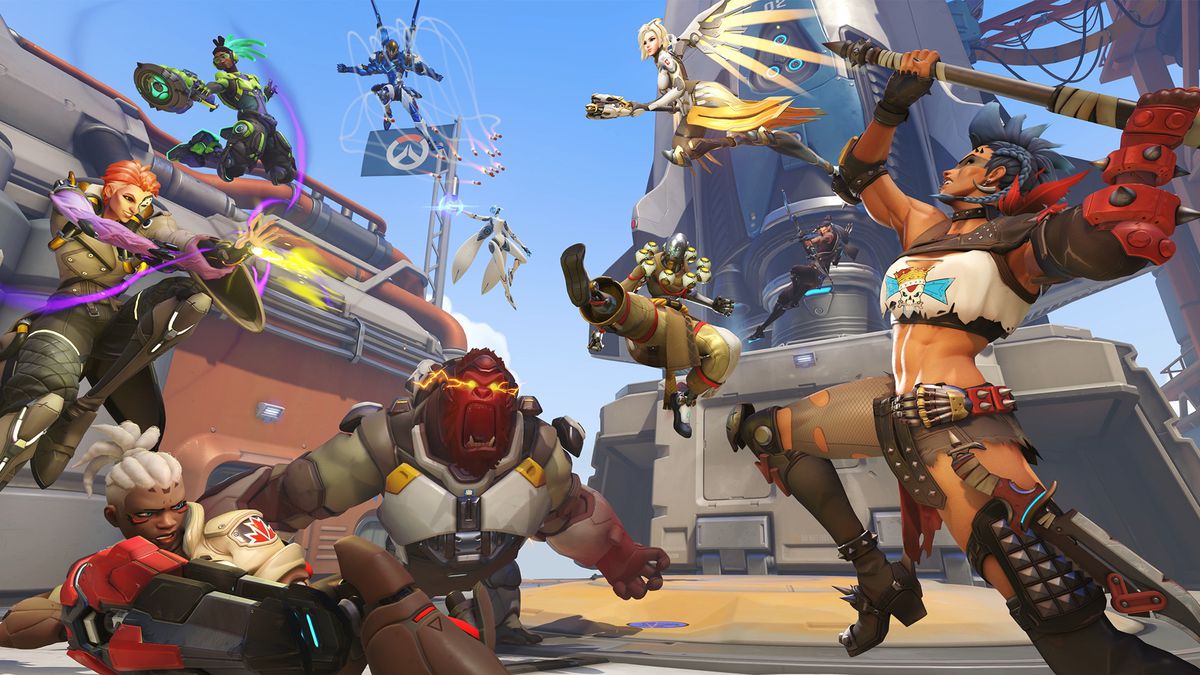Overwatch 2: Starting From the Bottom
One of the most anticipated titles of the year lands with.... a long wait; but how does it play?

On October 4th, the world at large finally got a chance to experience Overwatch 2 (OW2), Blizzard's exciting new waiting-in-line simulator.
Yes, the first day was rough, as it typically is for any big-deal online game. It took me 2.5 hours to get into a game, but I don't hold that against Blizzard - it wasn't entirely unexpected, and it did give us some hilarious videos of streamers having public meltdowns at the sight of 30k-long player queues. And the frequent disconnects that plagued some players - the result of multiple DDoS attacks - are sure to be ironed out in the coming days and weeks.
As I write this, the internet is ablaze with content from the lucky few who've managed to fight through the "unexpected error" messages and hours-long queues. Most of these people are high-tier players from the original Overwatch. They might not be the best of the best, but they're well above the average. These are the people for whom the game was redesigned.
None of that describes me. I played Overwatch in the nether tiers, teamed with people who had no idea what they were doing. Most of my matches consisted of me desperately trying to save the lives of players who seemed like they were trying to rack up as many deaths as possible. And Overwatch 2 worries me. This game was not designed with me in mind, and every instinct in me says that Blizzard has just amplified my headaches.
I am, however, a fair-minded individual, more than happy to give the developers the benefit of the doubt. So how does the game look for someone who could barely reach Gold on his best day?

5v5 teams
The most obvious change, of course, is the shrinking of teams from six players per side to five, specifically reducing the number of Tanks per side to one. As a low-tier player, this is something that terrified me when I first heard about it. To shed the diplomatic niceties for a moment, low-level OW1 games were full of Tank players who played their heroes in spectacularly idiotic ways that didn't make any sense. Having two Tanks per side meant that you were more likely to have someone who understood the basics of the role.
In practice, though, the new five-player teams aren't as big a deal as one might think. 90% of the time, the game plays exactly as it did in the previous iteration, and the absence of that second Tank isn't immediately felt. Insofar as the player does feel the change, it's an improvement more often than not, with engagements being shorter and quicker.
That other 10% of the time? Hypothetically (because it's not like this happened to me in multiple games or anything), let's say that I'm on defense and one of my teammates, who's feeling very self-destructive that evening, runs right up to the enemy spawn room and dies within seconds of the match starting. This was always a problem as the easiest way to lose a team fight is to be down a player, but it's worse now as the players on a smaller team count for more. A 4v5 is a lot harder to win than a 5v6.
If you've never experienced this yourself, then be prepared. A game always gets a flood of uninformed newbies when it goes free-to-play.
Map design
OW2 includes a lot of new maps, all of which were clearly designed with the smaller teams and faster play style in mind. The old 2CP maps are completely gone, to no one's lament. There is one new mode - Push, which is basically two-way Escort - but it doesn't amount to much. What does matter is the overall design principle.
The new maps are largely composed of straightaways leading to open arenas with lots of points of ingress. While OW1 maps were designed primarily around the Tanks (really Reinhardt, the ur-Tank), the OW2 maps are clearly intended more to accommodate the Damage heroes. That means lots of high ground, blind turns for ambushes, snaky little side paths for flanking, and little pocket arenas sized just right for duels. Understanding the architecture of these maps is key for playing any role, but unless you got in on one of the open betas, it's all fresh ground. That's all right, though, because everyone sucks at OW2 right now.

Tanks
Now we get into the roles, and I'm kind of obligated to start with the lonely little Tanks.
OW1 was a game built around barriers. In Team Fortress 2, the players tended to be scattered all over the place, and you'd certainly never have everyone clustered together where a single crit-boosted rocket could wipe a whole team. But in OW1, you were far less likely to see big, abrupt team kills like that because Reinhardt had everyone covered. The existence of barriers led to the poke-brawl gameplay flow that tended to involve a lot of big, close-in team fights.
But Blizzard has decided that barriers are boring, which is why they are weaker and you'll never see more than one per side in OW2. The role of the Tank - to control/contest objectives and create space for the rest of the team - has not fundamentally changed, but the way they accomplish this is much different. OW2 Tanks are a lot more aggressive and are called upon to do more for their teams. Accordingly, they are also a lot more powerful, and this is something that one feels immediately. Shoving back the entire enemy team single-handedly is tremendously satisfying.
Here, I need to take a moment to address a trivial interface addition that no one is talking about, but is actually pretty neat. The old medal system has been scrapped, and in its place, there is a leaderboard with three more-or-less role-specific metrics: Damage, healing, and mitigation. The last one is new, and tracks damage that never took place because (usually, though not exclusively) the Tank stopped it. This replaces the old "Barrier blocked" card, though it also counts projectiles that were absorbed or reflected as well as abilities that reduce or nullify incoming damage. It's a small thing, but it is nice that the Tanks get a metric all their own.
Damage / DPS
The very first game I played, I went into the flex role and was, to my shock, queued in as a Damage hero. After two years of waiting for 10+ minutes for Damage, that was a bit bracing.
In the low- and even mid-tiers of play, the role of Damage heroes is to die - usually because the players controlling them get a little overeager. OW2 is all about being overeager, though, and as I said the maps are really designed around these heroes. This does not make them easy, though - quite the opposite. I have never been more aware of how frail the Damage heroes are than in the first few hours of OW2. With only one Tank and fewer barriers to hide behind, Damage heroes die very quickly if they come under fire.
The new maps very much favor a stick-and-move playstyle - find a good position, open fire for a few seconds, then quickly retreat and reposition before the enemy team spots you and you get pinned down. This requires an intimate knowledge of the maps which almost no one has at the moment. Until more players acquire that knowledge, the life of the Damage hero is nasty, brutish, and short.
Support
I'm a Support main, and among the dedicated healers, there was a lot of talk as to what the single Tank would mean for Supports. As it turns out, it's actually not that bad. With a smaller team but the same number of Supports, there's actually a bit less stress to keep everyone alive. In practice, this means that Supports (especially those with longer-range weapons) get to do a little more fighting. And when I say "get to," I really mean "are expected to" - if all you're doing is healing, you're probably letting the side down, especially if your Damage heroes can't shoot straight (not that this is ever a problem in low ranks or anything).
Supports get another trivial interface addition that no one is talking about, but is actually pretty neat. As a Support player, one will get a notification for saving a fellow teammate, much as one gets a notification for eliminating an opponent. What's more, the stats page tracks this, with a big "players saved" number for Supports. As with the mitigation metric, this is very much appreciated. The Support role has a reputation for being thankless, so this is more meaningful than it might seem.
But how does it feel?
When the first betas went live, OW2 was presented as far more of a free-for-all brawl than OW1 - faster-paced with players on their own far more often. This has remained true as the game went live. If OW1 was an attempt to synthesize Team Fortress 2 with elements of a MOBA, then OW2 takes the original and mashes it up with current popular titles such as Apex Legends and Valorant.
I have no doubt that this makes the game more interesting to watch. It remains to be seen if it is better to play, but it is certainly different to play. OW2 has a dramatically different feel than its predecessor, despite the changes being relatively small on the surface. The impact on the competitive ladder is likely to be even greater, but I'm not going to risk that until the servers are just a touch more stable.
If nothing else, the long wait times mean that there is renewed interest in the game - and one day, I may get to the front of that line again.
